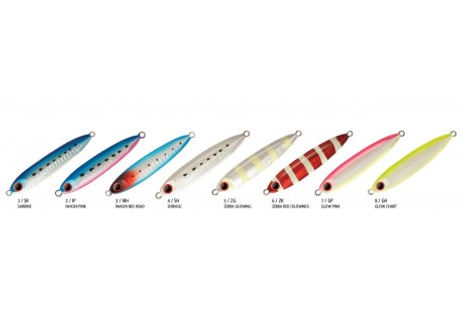

VERTICAL JIGGING AND SLOW PITCH


Jigging is a sport fishing technique that uses an artificial lure called a jig, usually made of metal and elongated, to attract and catch predatory fish. This technique can be practiced both from a boat (vertical jigging) and from the coast (shore jigging).
Vertical Jigging:
It is practiced from a boat, lowering the jig vertically toward the bottom and animating it with up-and-down rod movements, alternating between jerks and pauses.
The goal is to make the predatory fish perceive the jig as easy and vulnerable prey.
Specific rods and reels are used for this technique, capable of supporting the weight of the jig and the force of the fight.
Shore Jigging:
It is practiced from the coast, casting the jig and retrieving it with movements similar to those of vertical jigging.
It is a popular technique in Japan, Greece, and, increasingly, in Italy.
It allows you to target various species of predators that live near the coast, such as amberjack, snapper, and leerfish.
Main characteristics of jigging:
Lure:
The jig is the fundamental element, made of metal and available in shapes that can vary to adapt to different conditions.
Movements:
The jig's retrieval action is characterized by jerks and pauses, simulating the movement of injured or struggling prey.
Equipment:
Specific rods, reels, and lines are used for jigging fishing, capable of withstanding stress and ensuring good sensitivity.
Prey:
Jigging can be used to target a wide range of predatory fish, both in saltwater and freshwater.
In short, jigging fishing is a dynamic and exciting technique that requires specific equipment and a good knowledge of retrieval techniques to be successful.

Slow-pitch fishing is a vertical fishing technique based on slow movements and simulated falls of an artificial lure, designed to attract predatory fish. It is a variation of vertical jigging, but with a more delicate and targeted action, ideal for fishing in winter or in calm sea conditions.
In detail, slow-pitch fishing is characterized by:
Slow movements and falls:
The artificial lure (jig) is animated with light jerks and pauses, simulating the movement of an injured or struggling fish.
Specific lures:
Specially shaped jigs are used, often flat, which slide through the water as they sink, creating vibrations and lateral movements that attract predators.
Equipment:
Requires a specific rod with a progressive action, a lightweight spinning reel, and a thin but strong braided line.
Technique:
It's based on a balance between retrieve and pause, taking advantage of the lure's movement during its descent, when it's horizontal, or in free fall, moments when bites often occur.
In short, slow pitch is a fishing technique that focuses on the quality of the lure's movement and its ability to attract predators with a natural, non-aggressive action.